Thinning Hardwood Plantations
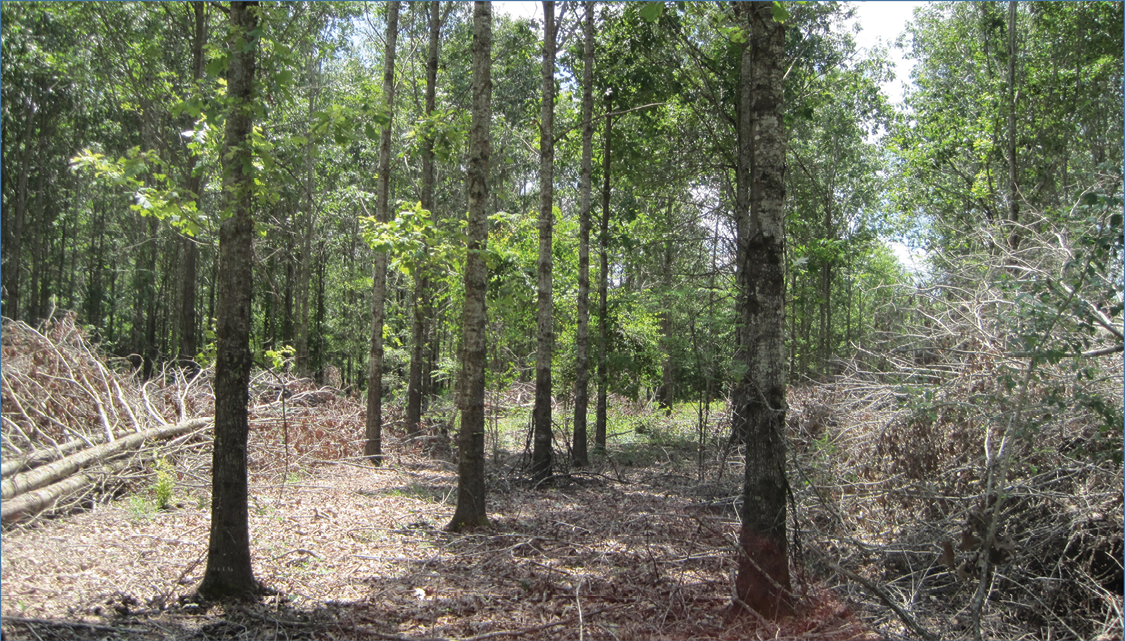
Compared to pine management knowledge, information on hardwood silviculture is more limited. Most research in hardwood systems focuses on naturally regenerated stands and early establishment methods for artificially regenerated plantations. There are several reasons for the limited hardwood silviculture research, including the amount of time required to reach maturity, the vast number of environmental and management variables, and the desire to conclude research projects inside the span of a researcher’s career. These factors, combined with the relatively new practice of establishing hardwood plantations by planting seedlings (vast majority established in the last 30 years), result in limited management information for this stand type.
As of 2017, hardwood plantations had been established on 477,000 acres in the Delta region of Mississippi alone. Much of this acreage was planted using federal and state cost-share funding through programs like the Conservation Reserve, Wetland Reserve, Environmental Quality Incentives, and Forest Resource Development Programs. These incentive programs continue to encourage planting hardwoods on marginal croplands, fallowed ground, and after timber harvesting to improve water quality, wildlife habitat, and timber production. Funds from these programs have financed most hardwood plantation establishment efforts across the Lower Mississippi Alluvial Valley (LMAV) through both cost-sharing of establishment costs and annual easement payments.
While establishment procedures have been developed for plantation silviculture, research on long-term management of these areas has not been completed. While this research is currently underway, the need for management options is becoming apparent. Many landowners are interested in performing thinning operations in this stand type. This publication presents options for managing these stands in the event that thinning is a requirement of program enrollment or deemed biologically desirable. Management techniques detailed here have been developed working under the assumption that planted trees’ life history, growth, behavior, and ecology follow the same principles as those observed in natural hardwood stands.
Biological Needs versus Harvesting Requirements
Market conditions often limit harvesting at the appropriate time. All forest stands reach a stage called stem exclusion, when intraspecific (between individuals of the same species) and interspecific (between individuals of different species) competition result in substantial levels of natural mortality in young hardwood forests. This process happens relatively early during the rotation (period of time that a stand of trees is grown) for natural stands, typically occurring during the first few years of a stand’s life. Because of the high seedling density in natural stands, intense competition develops quickly, resulting in the elimination of genetically inferior or resource-limited seedlings. This natural process results in survival of only higher vigor specimens. By the time these trees warrant a thinning operation due to biological/silvicultural needs, average tree size and bole quality is typically at a level that is commercially marketable.
In contrast, due to cost and cost-share program allowances, hardwood plantations are planted at low seedling densities. As trees mature, these low densities do not force tree-on-tree competition at an early age. Often, widespread stem exclusion does not occur until the stand reaches an age of 15 to 40 years. The resulting wood is much lower in quality because of limb scarring from poor self-pruning (Figure 1). While the diameter of these trees may fit within the range of merchantability limits, bole quality is often very low. It is usually very difficult to find logging contractors willing to perform thinning operations in these stands. In addition, it is often more appropriate to approach the lowest quality plantations with a “hands-off” mindset as a precaution against maintaining low-growing live limbs for a much longer period of time once post-thin light levels are increased. These and other considerations are discussed in more detail below.
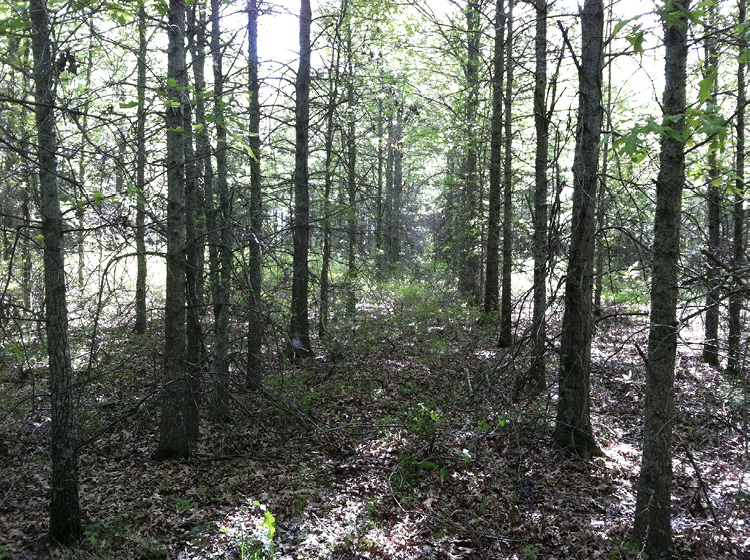
Characteristics of Hardwood Plantations
Hardwood stands are much more complex than pine stands both in ecological function and proper silvicultural management. As previously stated, most existing hardwood management knowledge is based on natural stands. Plantation management encompasses a different set of biological interactions and constraints that forest managers must consider.
Site productivity and condition are also major influences to consider regarding thinning expectations for hardwood plantations. The potential for a site’s productivity is driven not only by quality (capability) of soils present, but also by the ability of a given species to grow there. While the inherent productive capacity of a site influences the growth of trees planted on it, excluding drainage manipulation, managers cannot affect site variables enough to impact long-term productivity of a stand.
Species/site relationships are an important consideration during plantation establishment. Mismatching species to a site is one of the more common mistakes made in planting efforts. Hardwood species often do not have a wide range of site suitability. Even within the same species group, different species may have vastly different soil, moisture, and nutritional tolerances. For example, cherrybark oak is unsuitable for growing on wet, clay soils of higher pH, while Nuttall oak thrives under similar conditions. Managers ignoring these basic traits often see regeneration failure; however, problems of a longer nature can also result (Figure 2). For more detailed information on species/site relationships in bottomland hardwoods, please read Mississippi State University Extension Publication 2004 Bottomland Hardwood Management: Species/Site Relationships.
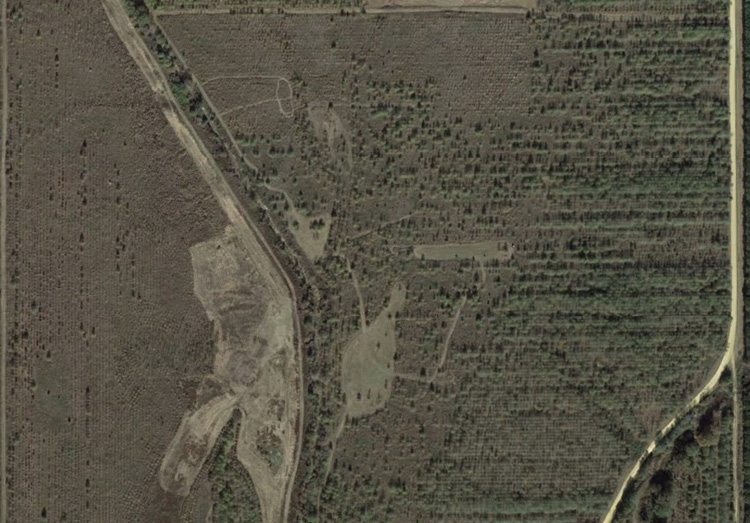
Inadequate consideration of species/site relationships very often results in heavy, but not total, mortality. Subsequently, wood quality is usually very poor across the stand, leaving few options for thinning operations. When assessing hardwood plantations for a first thin, use a threshold of 30–40 percent mortality. If this level of mortality is observed evenly across the plantation, it is unlikely that future wood quality will be sufficient to warrant continued silvicultural management. However, if mortality is grouped, leaving “clumps” of trees and “holes” in the plantation, thinning within groups of trees may be possible.
As noted previously, hardwood plantations are planted using much lower seedling densities than would be encountered in natural regeneration. Limited funds necessitate low numbers of planted trees per acre (TPA). Some of the more common recommended planting densities have been 12-by-12 feet (302TPA), 12-by-10 feet (363TPA), and 10-by-10 feet (435TPA). Without additional natural seeding from adjacent stands, these densities are not adequate to create the early competition and mortality observed in young naturally regenerated forests, which typically contain thousands of seedlings (Figure 3). Consequently, lower bole quality results as these trees mature without undergoing early natural pruning. These stems have larger, low-quality cores compared to those grown in naturally regenerated stands. This problem is intensified in scenarios where higher levels of early mortality (often encountered in these stands) exacerbate problems with low-quality wood production. When planted tree survival falls to 70 percent or lower, living branches do not die, and self-pruning may be delayed for several additional decades (Figures 4 and 5).
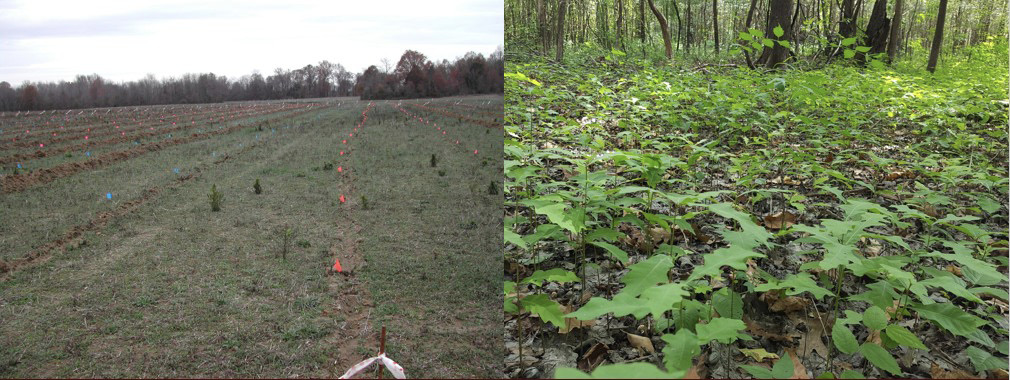
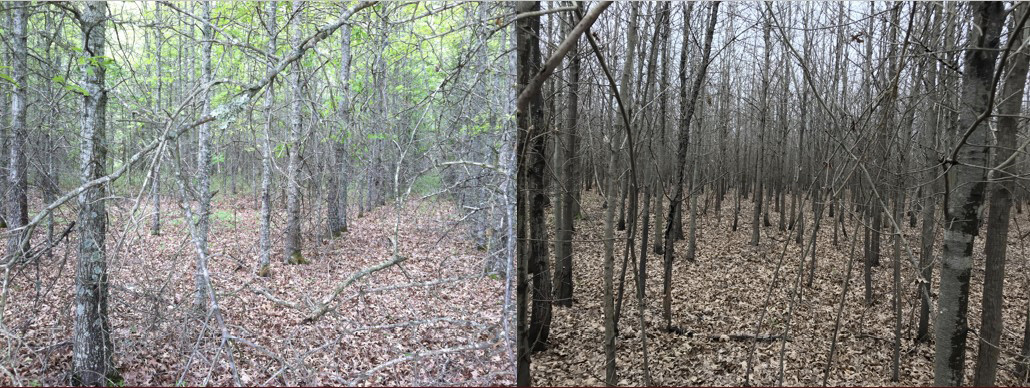
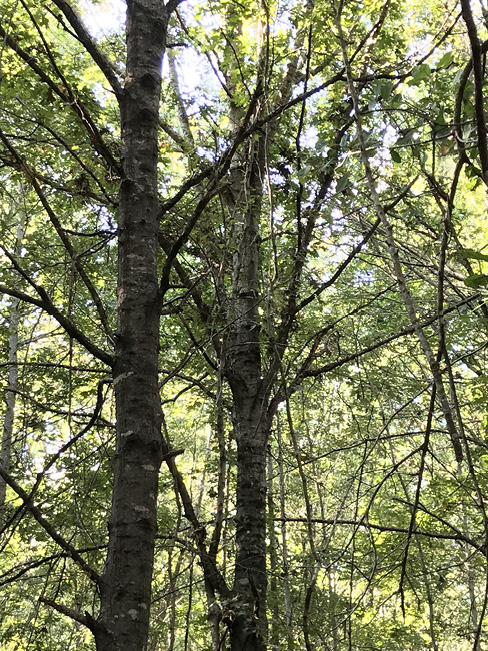
Species composition is typically another differing characteristic between natural and plantation stands. Natural stands usually have multiple species growing together simultaneously, while plantations are often planted using only one or two species. Traditionally, the intent in hardwood plantation silviculture is that adjacent stands serve as seed sources for enrichment through wind-dispersed seeding by light-seeded woody species (e.g., sweetgum, red maple, green ash; Figure 6). In natural stands, multiple tree species growing together benefits the stand as a whole. This interspecific competition enhances processes such as natural pruning and prioritization of stem height growth (Figure 7). While this process may occur near plantation edges and across very narrow plantings, sufficient numbers of light-seeded species are rarely distributed across larger planted stands. Consequently, beneficial early competition does not occur, and stand quality and growth is decreased in hardwood plantations.
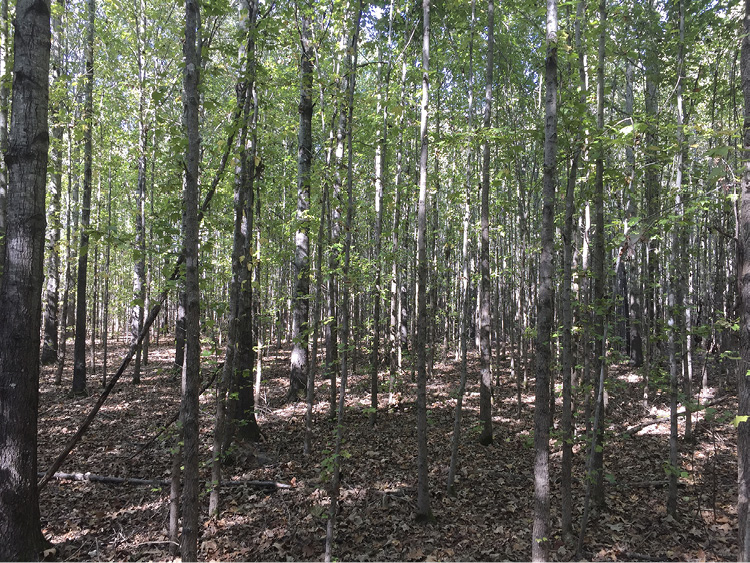
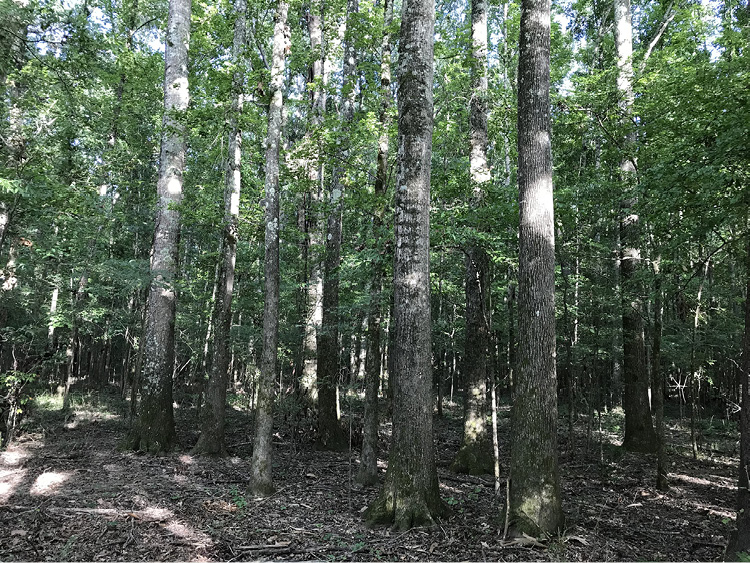
Plantation Development
Developing a hardwood stand is a complicated process where multiple environmental variables work both for and against individual trees over time, resulting in a stand best adapted to the site and competition conditions that occurred throughout its rotation. There are several overlapping stages during this period of development. During the first year after planting, initial mortality can occur in the form of planting shock due to inferior planting stock and/or poor planting techniques. In addition, mortality during the first 5 years results from the inability of young seedlings to compete successfully with onsite vegetation for nutrients and moisture.
During the first 10 years, light-seeded woody species often encroach. These stems provide interspecific competition, which forces planted trees to differentiate into crown classes typically during the first or second decade after planting. Typically, canopy stratification (formation of distinct canopy layers) occurs shortly thereafter (10 to 25 years after planting), leading to the period of increased tree mortality at some point when the stand reaches 15 to 40 years. Once a stand has reached 35 to 40 years of age, mortality typically stabilizes, and growth and health diminish over time. This is an expected natural process, and understanding these stages gives managers an opportunity to influence future quality and value of a stand while capitalizing on stems that would die and be unused without thinning.
Is It Time to Thin?
This publication has described differences between natural and plantation stands, along with factors that influence wood quality. From this point forward, we will explore the process of assessing if a plantation is ready to thin and how to proceed with a thinning operation. In addition, while overall goals vary and determine future management of any stand, this publication is written with high-quality timber production as the primary management goal.
The first step in any timber management effort is determining current plantation conditions and whether these conditions can lead to achieving landowner goals for the stand. Several pieces of information are needed in order to accurately assess a plantation’s readiness for a thinning operation. Some of these include species, average diameter at breast height (DBH), height to live crown, merchantable height, crown class, potential log grade, and tree class. These data are used to calculate metrics such as TPA, basal area (BA), stocking percent, and overall tree class distribution for the plantation (Figure 8).
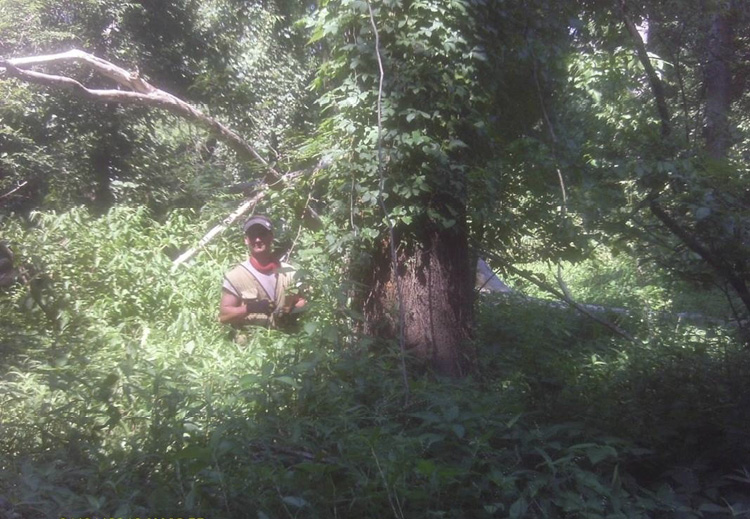
Obviously, if the current predominant species in a plantation does not or is not expected to have future commercial value, continued management of the stand is not advisable. Undesirable stems can often simply be removed during thinning operations. However, if the level of undesirable species is too high or there are too few stems of desirable species, harvesting the entire stand may be the best option.
Even though trees in a plantation should be the same age, all will not be the same size. These differences occur due to microsite variance, genetic differences, and competitive position. Consequently, thinning operations are often not possible until smaller trees in the stand are merchantable. Typically, using average tree DBH or height in conjunction with local merchantability limits as a thinning guide will not suffice because the bulk of trees targeted for removal will have smaller stems. As a result, average DBH in thin-appropriate hardwood stands is typically higher than in comparable pine stands. Average DBH should be 8 inches before giving serious consideration to thinning hardwood plantations. Thinnings should also occur at a later age (25 to 35 years minimum on only the best sites) than in pine settings.
In addition to the straightforward inventory measurements commonly collected (e.g., DBH, merchantable height), several different, but interrelated, more complex metrics should be evaluated when determining if it is time to consider thinning a hardwood plantation. While future quality is a concern in pine silviculture, early thins are primarily a means of density reduction. These parameters become much more important when predicting the potential of a hardwood plantation. Some of these include height to live crown, crown class, potential for future log grade, and tree class.
Characterizing hardwood stands is a more qualitative process than for pines. As a general rule, for best growth and health, maintain oaks grown in hardwood plantations at a live crown ratio of 40 percent (40 percent of the height of a tree contains live branches) or greater. These crowns should be vigorous, full, and even. Log grade evaluations should determine whether the expected future quality of post-thin residual trees merits continued management. If high proportions of the stand exhibit low trunk forks (within the first 20 feet of height), multiple living branches in the lower 20 feet of stem, stem defects (e.g., cankers, large diameter living branches, cavities, seams), or other damage, immediate or continued management may be questionable (Figures 9 and 10). For more information on hardwood log grading, see Mississippi State University Extension Publication 3179 Grading Hardwood Trees: A Guide to Identifying Stem Quality in Hardwood Stands.
Overall stand vigor should be high enough that expectation of epicormic branching is low. Epicormic branching (limbs sprouting from dormant buds underneath bark on the trunk or limbs of a tree) is a physiological response to increased light/heat reaching the bole or a result of reduced overall vigor (Figure 11). Branches reaching three-eighths of an inch or larger in diameter are classed as defects in log grading. Consequently, the presence, or future likelihood, of these branches may dictate timing of thinning operations. In addition, different species have varying probability of epicormic branching ranging from relatively low (e.g., cherrybark oak) to very high (e.g., water and willow oak) levels.
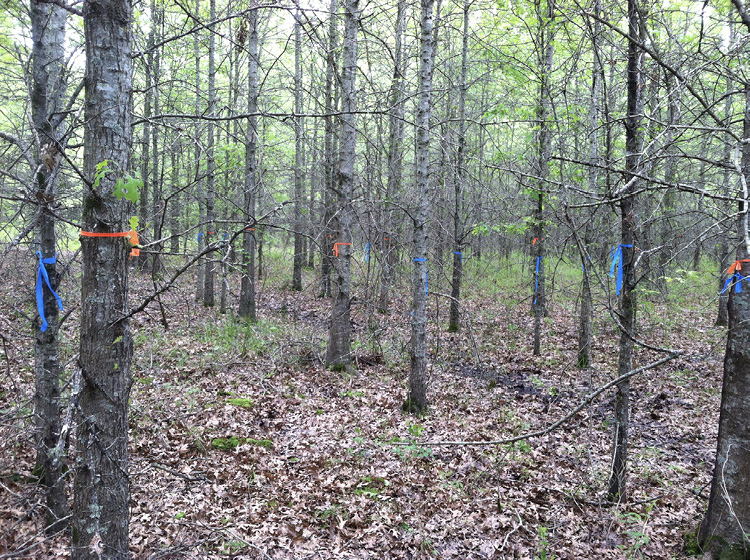
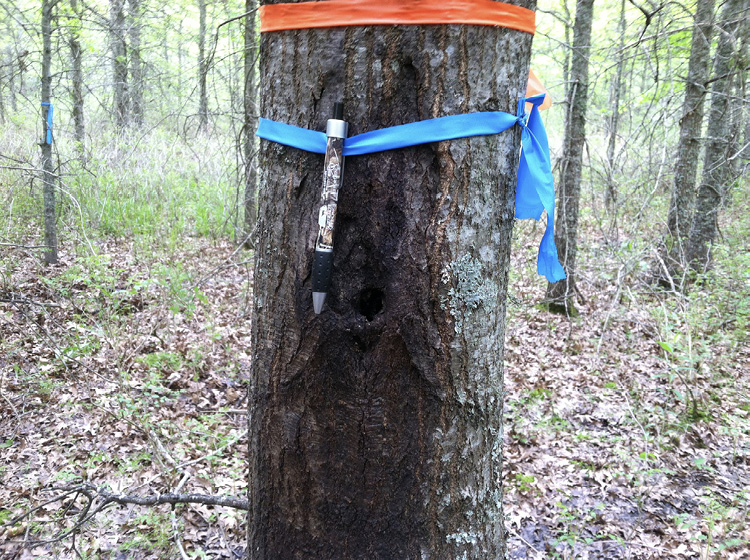
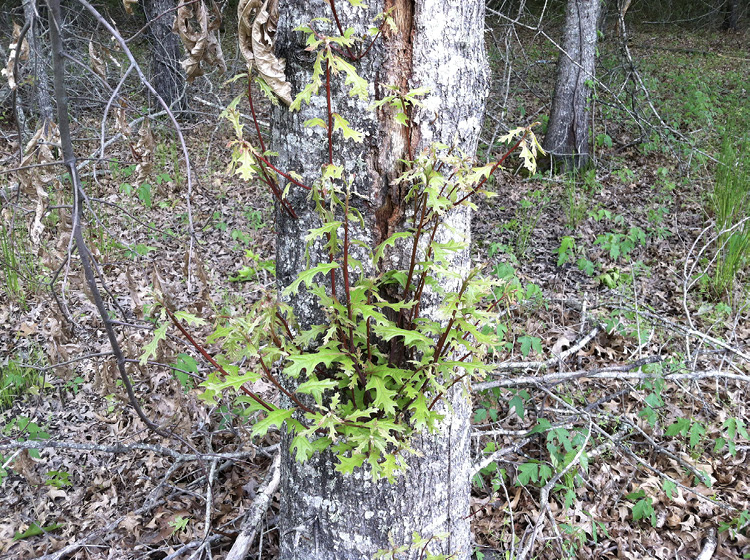
Assuming appropriate qualitative stand conditions are met, overall stand density should be evaluated. Hardwood stands are best managed through density regulation via thinning to a predetermined level of residual stand density. As detailed above, hardwood plantations are typically established using low initial planting densities. These low densities severely limit thinning options as these stands mature. Typically, harvesters want to remove around 150 TPA and 25 tons per acre of material for economic feasibility in first-thin logging operations. With average initial densities ranging between 302 and 435 TPA, early first-thin viability is possible only on the best sites with high survival. At these densities, minimal stem removal at a level profitable for logging will only leave 50 to 65 percent of the initial stand density. If the plantation has experienced substantial mortality, residual stem numbers will often be too low for optimal future growth after an economically viable first-thin. Also, as previously discussed, development of high-quality logs requires natural pruning during the early years of a stand’s rotation, and increased light levels that encourage epicormic branching in lower density stands limit this process. Consequently, lower survival will typically delay profitable thinning until trees gain diameter/tonnage.
In pine silviculture, stocking guides can be used to determine when a stand needs thinning as well as the optimal stocking level for residual stems. However, we do not have tested stocking guides for optimal residual tree density for southern bottomland hardwoods in natural or plantation settings. Goelz (1995) developed a bottomland hardwood stocking guide based on hypothetical stocking levels for hardwood stands before and after thinning. In this model, prethinned stand density represents 100 percent stocking, and optimal residual density is considered fully stocked. In the absence of tested models, this stocking guide can be used for estimation in hardwood plantation thinning efforts.
Given an estimate of TPA and basal area, guides can provide estimated stocking. Stands with stocking estimated at 100 percent or greater are overstocked and should be candidates for thinning if stand conditions are favorable. A stocking level of 60 percent is considered fully stocked and is the optimal post-thin density. Stands with stocking levels between 60 and 100 percent can be considered thinning candidates if logging is profitable and a sufficient number of residual trees are maintained to future management viability. Stands with stocking levels between 40 and 60 percent should be considered stocked and allowed to grow. Stands with stocking levels below 40 percent are understocked and should not be thinned.
How Do I Thin a Hardwood Plantation?
Forest landowners and managers may be familiar with the general concept of thinning, but often they do not realize that there are several different techniques. These techniques are designed to remove undesirable stems for various reasons (e.g., damage, disease, undesirable species, poor form) or to reduce stand density so that residual trees have sufficient room for future growth. However, proper implementation is necessary to ensure that operations are not detrimental to stand quality. Properly designed silvicultural thinning removes targeted trees, resulting in concentrated growth on residual stems of the highest quality in the current stand. Retain a sufficient number of trees that are capable of using the increased available growing space.
Uniform mechanical row thinning is the most familiar first-thin method to many forest owners and managers. Row thinning is commonly used in pine plantation silviculture because it is simple, has lower damage potential for residual trees, and creates access for equipment through removal rows. The goal of this thinning method is quantitative (i.e., removing trees results in lower density) without consideration for stem quality. The process works by removing rows at a set interval. Typically, every third or fourth row is removed, and, if needed to reduce stand density, lower quality stems are removed from residual rows.
As mentioned above, pine and hardwood thinning focus on different priorities and considerations. Proper hardwood thinning requires much more consideration of variables affecting residual stem quality. While removing trees on an individual stem basis would allow maximum quality retention, logging operators need enough space to move equipment through a stand during thinning, and row openings are needed for this movement. Row thins do not allow for quality consideration within removal rows, so lower interval row thins (third- and fourth-row thinnings) should not be used in hardwood plantations. While it is not possible to select individual trees in removal rows, fifth-row thinning is a compromise between equipment access and maximized quality retention.
Fifth-row thinning, combined with selective removal of lower quality trees within residual rows, allows for stand density reduction while maintaining as many high-quality trees as possible (Figure 12). Select trees for removal in residual rows using the health and quality considerations discussed above (Figure 13). Targeted residual density should follow suggestions provided in Table 1 to allow for continued growth of the post-thinned stand. Remember, density information listed in Table 1 is just a suggested target. Residual stands must contain a sufficient number of stems to remain manageable in the future. Optimally, 130 to 180 trees (≥ 60 ft² of basal area) should remain after first-thin operations. Subsequent thinnings will be performed by selecting trees for removal on an individual stem basis to reduce density back to the appropriate level.
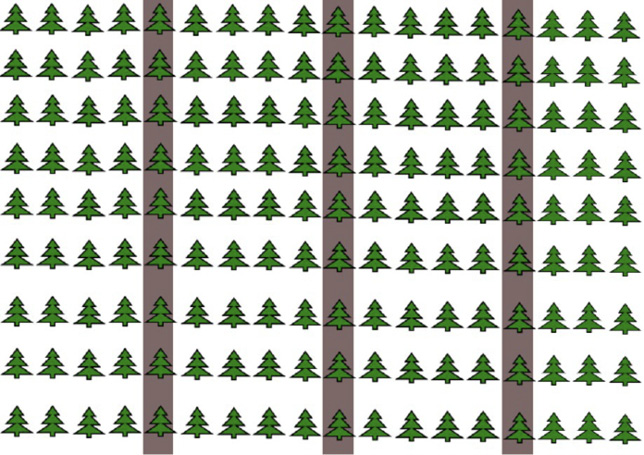
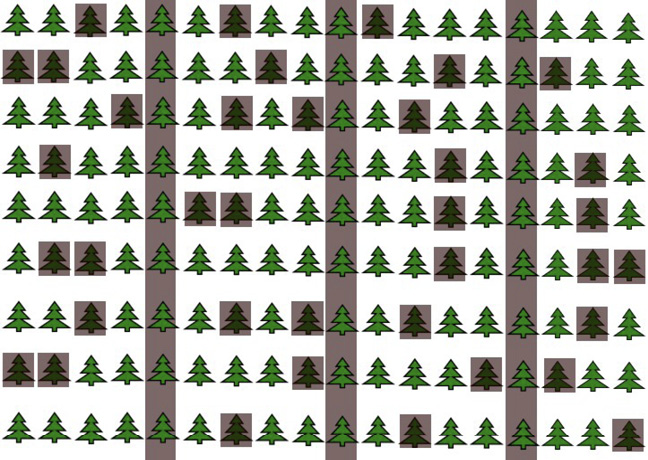
|
Stocking level |
Average DBH |
Trees per acre |
Basal area |
Stocking percent |
|
Understocked |
8 |
130 |
46 |
40 |
|---|---|---|---|---|
|
10 |
95 |
52 |
40 |
|
|
14 |
58 |
62 |
40 |
|
|
Fully stocked |
8 |
177 |
62 |
60 |
|
10 |
125 |
68 |
60 |
|
|
14 |
70 |
75 |
60 |
|
|
Overstocked |
8 |
305 |
106 |
100 |
|
10 |
215 |
117 |
100 |
|
|
14 |
118 |
126 |
100 |
Special Considerations
Even when hardwood thinning operations are designed and implemented correctly, negative issues may arise. In addition to the possibility of epicormic branching, residual tree boles can be damaged by equipment and/or severed trees during operations. Damage to hardwood stems during logging operations is a more serious concern than in pine silviculture. Hardwood trees do not have the sealing ability of pine species. When a wound penetrates the bark of hardwood species and damages the cambium (thin layer of vascular tissue responsible for water and nutrient movement within a tree), organisms such as fungi and bacteria enter and cause decay and/or discoloration of wood. Both result in log volume and value losses. In addition, bottomland sites are “wetter,” so physical site damage (e.g., rutting and compaction) is common in these areas. Logging operations during wet weather can cause lateral root damage from exposure, breakage, or soil compaction.
Use logging companies with hardwood and wet site thinning experience if possible. Skid trails and loading decks should be placed in a manner that minimizes overall damage to residual trees and the site. If large saplings are near residual trees, leave them to protect against damage from equipment and skidded trees. If possible, do not use large equipment when thinning hardwood plantations. Use smaller cutters and skidders with narrower tires to minimize bole damage to residual stems (Figure 14).

Suggested Reading
Ginrich, S. F. 1967. Measuring and evaluating stocking and stand density in upland hardwood forests in the central states. Forest Science, 13(1), 38–53.
Goelz, J. C. G. 1995. A stocking guide for southern bottomland hardwoods. Southern Journal of Applied Forestry, 19(3), 103–104.
Gottschalk, K. W. 1997. Stem quality of oak in 15-year-old stands: Influence of species within harvesting treatment and fencing. In: Spiecker, H.; Rogers, R.; Somogyi, Z., comps. Advances in research in intermediate oak stands; 1997 July 27–30; Freiburg, Germany. Freiburg, Germany: Institute for Forest Growth, Albert-Ludwigs-University of Freiburg: 85–97.
Self, A. B. 2021. Bottomland hardwood management: Species/Site relationships. Mississippi State University Extension Publication 2004. 4p.
Self, A. B. and K. Cunningham. 2018. Grading hardwood trees: A guide to identifying stem quality in hardwood stands. Mississippi State University Extension Publication 3179. 8p.
Publication 3565 (POD-01-24)
By Brady Self, PhD, Associate Extension Professor, Forestry.
The Mississippi State University Extension Service is working to ensure all web content is accessible to all users. If you need assistance accessing any of our content, please email the webteam or call 662-325-2262.




